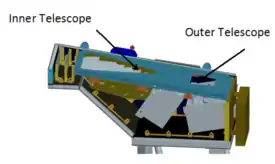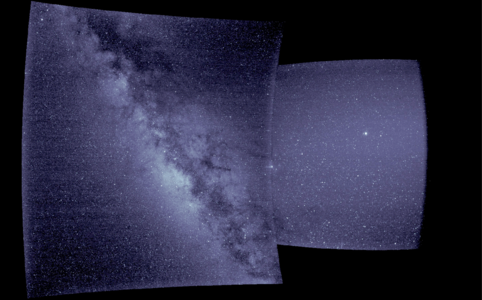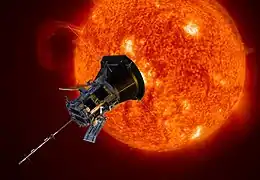WISPR
The Wide-Field Imager for Solar Probe (WISPR) is an imaging instrument of the Parker Solar Probe mission to the Sun, launched in August 2018.[1] Imaging targets include visible light images of the corona, solar wind, shocks, solar ejecta, etc.[1] Development of WISPR was led by the U.S. Naval Research Laboratory.[2] The Parker Solar Probe with WISPR on board was launched by a Delta IV Heavy on 12 August 2018 from Cape Canaveral, Florida.[3] WISPR is intended take advantage of the spacecraft's proximity to the Sun by taking coronagraph-style images of the solar corona and features like coronal streamers, plumes, and mass ejections.[4] One of the goals is to better understand the structure of the solar corona near the Sun.[4]

WISPR is designed to study the electron density and velocity structure of the corona.[5] The instrument field of view is planned to extend from 13 to 108 degrees away from the Sun, and does not directly image the Sun; the area of interest is a very wide field extending away from the Sun.[1]
WISPR includes two separate telescopes, each with a radiation-hardened CMOS imager with resolution of 2,000×2,000 pixels.[6] The CMOS sensors are an active pixel sensor type of detector.[7]
The WISPR first light image was published in September 2018.[8] In December, a view of the corona including a coronal streamer was released.[9]
In November 2018, a video of WIPSR recording solar wind during the spacecraft's first close pass to the Sun was released.[10] One project scientist noted, "The data we’re seeing from Parker Solar Probe’s instruments is showing us details about solar structures and processes that we have never seen before,"[10]
Development
The stray light and baffle for WISPR was modeled during development of the instrument.[11] Two noted cases where stray material caused issue with space imaging includes the Infrared Telescope (IRT) flown on the Space Shuttle Spacelab-2 mission, in which a piece of mylar insulation broke loose and floated into the line-of-sight of the telescope corrupting data.[12] This was on the STS-51-F in the year 1985.[12] Another case was in the 2010s on the Gaia spacecraft for which some stray light was identified coming from fibers of the sunshield, protruding beyond the edges of the shield.[13]
Gallery
- First light in space

- First coronal view
In December WISPR's a view of the corona was published, including a coronal streamer.[9]
References
- "Looking at the Corona with WISPR on Parker Solar Probe". NASA/Goddard Media Studios. 16 April 2018. Retrieved 14 September 2018.
- "NRL's Sun Imaging Telescopes Fly on NASA Parker Solar Probe". U.S. Navy. 10 August 2018. NNS180810-19. Retrieved 14 September 2018.
- Brown, Geoffrey; Brown, Dwayne; Fox, Karen (12 August 2018). "Parker Solar Probe Launches on Historic Journey to Touch the Sun". Johns Hopkins University Applied Physics Laboratory. Retrieved 13 August 2018.
- "NRL's Sun Imaging Telescopes Fly on NASA Parker Solar Probe". U.S. Navy/Naval Research Laboratory. 10 August 2018. NNS180810-19. Retrieved 7 October 2018.
- "Wide-Field Imager for Solar Probe Plus (WISPR)". U.S. Navy/Naval Research Laboratory. Retrieved 14 September 2018.
- "Wide-Field Imager for Solar Probe (WISPR)". SRI International. Retrieved 14 September 2018.
- Garner, Rob, ed. (12 July 2018). "Parker Solar Probe Instruments". NASA. Retrieved 7 October 2018.
- Frazier, Sarah; Surowiec, Justyna (19 September 2018). "Illuminating First Light Data from Parker Solar Probe". Johns Hopkins University Applied Physics Laboratory. Retrieved 22 September 2018.
- JHUAPL. "Preparing for Discovery With NASA's Parker Solar Probe". Parker Solar Probe. Retrieved 2018-12-23.
- Garner, Rob (2019-08-12). "One Year, 2 Trips Around Sun for NASA's Parker Solar Probe". NASA. Retrieved 2019-09-16.
- M.-L. Hellin, E. Mazy, S. Marcotte, Y. Stockman, C. Korendyke, A. Thernisien, "Stray light testing of WISPR baffle development model," Proc. SPIE 10562, International Conference on Space Optics — ICSO 2016, 105624V (25 September 2017); https://www.spiedigitallibrary.org/conference-proceedings-of-spie/10562/105624V/Stray-light-testing-of-WISPR-baffle-development-model/10.1117/12.2296104.full?SSO=1
- Kent, et al. – Galactic structure from the Spacelab infrared telescope (1992).
- "STATUS OF THE GAIA STRAYLIGHT ANALYSIS AND MITIGATION ACTIONS". 2014-12-17. Retrieved 1 January 2015.
External links
- Looking at the Corona with WISPR on Parker Solar Probe (April 16, 2018)
